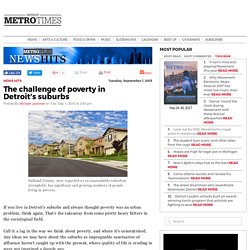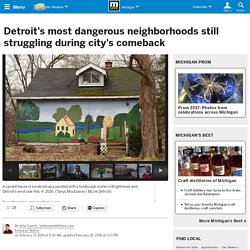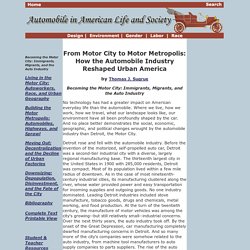

Jasmine Ramos
The challenge of poverty in Detroit's suburbs. Oakland County, once regarded as an unassailable suburban stronghold, has significant and growing numbers of people living in poverty.

If you live in Detroit's suburbs and always thought poverty was an urban problem, think again. That's the takeaway from some pretty heavy hitters in the sociological field. Call it a lag in the way we think about poverty, and where it's concentrated. Any ideas we may have about the suburbs as impregnable sanctuaries of affluence haven't caught up with the present, where quality of life is eroding in ways not imagined a decade ago.
The idea of suburban poverty began to gain currency in the immediate wake of the mortgage meltdown that crashed the U.S. economy. Over the last decade, statistics have borne out Leinberger's idea. That's something Lighthouse of Oakland County deals with every day. And the official federal poverty line is useful for finding only the very poorest, those earning less than $19,530 for a family of three. Detroit has highest concentrated poverty rate of 25 largest metro areas. Two new reports show that the poor in metro Detroit face unique challenges compared to other parts of the U.S., making it more difficult for them to escape poverty.

Detroit's most dangerous neighborhoods still struggling during city's comeback. The glow of downtown's comeback hasn't quite reached the street corner on Detroit's Eastside where 22-year-old James Rogers was walking recently.

While downtown is abuzz with development, the neighborhoods near Kelly Road and Morang Avenue are more recognizably "Detroit:" the ubiquitous liquor store; abandoned homes crumbling along trash-strewn side streets; a murder victim shrine with liquor bottles and stuffed animals piled knee-high around a street sign in sight of a school. "It's going to take a while to catch on," Rogers said about any revitalization in his beleaguered neighborhood.
Rogers says he was robbed just down Kelly a few months ago. Four guys rooted through his pockets while a fifth held him at gunpoint. Whites moving into Detroit, blacks moving out as city shrinks overall - Crain's Detroit Business. White people are moving back to Detroit, the American city that came to epitomize white flight, even as black people continue to leave for the suburbs and the city's overall population shrinks.

Detroit is the latest major city to see an influx of whites who may not find the suburbs as alluring as their parents and grandparents did in the last half of the 20th century. Unlike New York, San Francisco and many other cities that have seen the demographic shift, though, it's cheap housing and incentive programs that are partly fueling the regrowth of the Motor City's white population. "For any individual who wants to build a company or contribute to the city, Detroit is the perfect place to be," said Bruce Katz, co-director of the Global Cities Initiative at the Washington, D.C.
-based Brookings Institution. "You can come to Detroit and you can really make a difference. " The Great Migration (1915-1960) Black Family Arrives in Chicago from the South, ca. 1919 Image Ownership: Public Domain The Great Migration was the mass movement of about five million southern blacks to the north and west between 1915 and 1960.

During the initial wave the majority of migrants moved to major northern cities such as Chicago, Illiniois, Detroit, Michigan, Pittsburgh, Pennsylvania, and New York, New York. By World War II the migrants continued to move North but many of them headed west to Los Angeles, Oakland, San Francisco, California, Portland, Oregon, and Seattle, Washington. From Motor City to Motor Metropolis: Becoming the Motor City. From Motor City to Motor Metropolis: How the Automobile Industry Reshaped Urban America by Thomas J.

Sugrue Becoming the Motor City: Immigrants, Migrants, and the Auto Industry No technology has had a greater impact on American everyday life than the automobile. Where we live, how we work, how we travel, what our landscape looks like, our environment have all been profoundly shaped by the car. Detroit rose and fell with the automobile industry. Detroit: The New Motor City. Detroit, Motown, the Motor City.

Michigan and Detroit in particular became the center of the auto industry at the beginning of the twentieth century due to a number of factors. Steel, the Great Lakes shipping industries, and a large and growing workforce all contributed. Perhaps the most striking force though was the unique collection of inventors, dreamers, and designers that made the Detroit area their home. Ransom E. Detroit’s Bankruptcy Reflects a History of Racism. This is black history month. It is also the month that the Emergency Manager who took political power and control from the mostly African American residents of Detroit has presented his plan to bring the city out of the bankruptcy he steered it into.
This is black history in the making, and I hope the nation will pay attention to who wins and who loses from the Emergency Manager’s plan. Black people are by far the largest racial or ethnic population in Detroit, which has the highest percentage of black residents of any American city with a population over 100,000. Eighty-three percent of the city’s 701,000 residents are black. It continues to be an underreported story that a white state legislature and white governor took over the city and forced it to file for bankruptcy against the will of its elected representatives. It’s important to view what is happening to Detroit and its public employees through a racial lens.
Government was involved at a more micro level as well. Letter: Racism exists at Detroit Police Dept. Detroit Police Chief James Craig just doesn’t get it.

He doesn’t get racism exists in his department. He doesn’t get the irony of the whole situation — systemic racism flourishing on the watch of a black executive, in a mostly black department in a majority black city. The reality is all-white task forces exist on his watch. The reality is complaints from officers about harassment and discrimination flourish on his watch. Recently, Craig held a press conference to discuss a report from a committee he authorized to look at racial issues in the Detroit Police Department. Within the last few days that report became the center of controversy when the Coalition Against Police Brutality began calling for its release after Detroit Police Officer Daniel Wolff made some controversial statements on Facebook calling Detroit residents trash.
Anatomy of Detroit’s Decline - Interactive Feature. Mayor Coleman A. Young of Detroit at an event in 1980. Richard Sheinwald/Associated Press The financial crisis facing Detroit was decades in the making, caused in part by a trail of missteps, suspected corruption and inaction. Here is a sampling of some city leaders who trimmed too little, too late and, rather than tackling problems head on, hoped that deep-rooted structural problems would turn out to be cyclical downturns. Charles E. Detroit population rank is lowest since 1850. For the first time since before the Civil War, Detroit is not among the nation’s 20 most populous cities.

Detroit’s population was 677,116 as of last summer, a loss of 3,107 residents from the previous year, according to estimates released Thursday by the U.S. Census Bureau. That’s the smallest decline in decades, but it was enough to drop the city to 21st in the nation, surpassed by Seattle, Denver and El Paso, Texas. Research09 dissertationsummary. Wall that once divided races in Detroit remains, teaches. One-Fifth of Detroit's Population Could Lose Their Homes - The Atlantic. Updated 10/26/2014 Evone Brown, a 55-year-old former machine operator, survives on $850 a month from retirement and disability checks, which wasn't enough to cover the roughly $8,000 she owed in property taxes on her home on the east side of Detroit.

This year, because she was at least three years behind on her tax payments (most of which she inherited when she bought the house in 2011), Wayne County's treasurer foreclosed on her. As a result, her house is up for sale this week in Wayne County’s online foreclosure auction, at a starting bid of just $500. She will most likely be evicted this January. She’s not alone: As Detroit seeks to leave bankruptcy behind and get back on its feet—ramping up development with construction of a light rail and a new hockey arena that will cost the city hundreds of millions of dollars—it is simultaneously bearing witness to a process that could evict up to 142,000 of its residents, many of whom are too poor to pay their property taxes. 8 Mile helps people to understand the Detroit context better – Gavinsblog.com. The « 8 Mile » movie makes us discover and understand the racial tension and the racial split that existed in Detroit. In fact, this appartheit has historical roots in Nothern America.
In the 30s and 40s, southern Blacks moved to Nothern cities like Detroit. Many white people left the city to build their own communities. The racial tension that existed was so strong in Detroit that you could even find racial flags with sentences like « We want white tenants in our white community. » The racial contrast was more important in poor communities like Warren where people (Blacks and Whites) had nearly the same income.
Stuff Black People Don't Like - SBPDL: How Did it Come to This? WaPo Sheds Tears Over the Inevitable Collapse of Detroit. It is the opinion of SBPDL that the coming collapse of Detroit represents a watershed moment in American history. A mere 100 years ago, Detroit was nearly 100 percent white. Beyond the horizon, these white citizens envisioned a magnificent city, with opulent buildings, grand theaters for entertainment and a thriving economy that would be the envy of the world. If you build it, they will come. From the southern United States flowed "The Great Migration," as Black people saw that same horizon and realized they could never build an infrastructure for a city near the grandeur of Detroit.
For that matter, no record exists of any city that Black people have ever built with an economic infrastructure or low crime rate that didn't receive massive subsidization or entitlements from a government or charitable organization. White Flight - How Detroit Lost Its Way. Marilyn Salenger: ‘White flight’ and Detroit’s decline. By Marilyn Salenger By Marilyn Salenger July 21, 2013 Marilyn Salenger is president of Strategic Communications Services and a former correspondent and news anchor for several CBS stations. Detroit is a shocking example of "white flight." CofCC.org News Team. Whites moving to Detroit, city that epitomized white flight.